Norman Crowe
University of Notre Dame and University of New Mexico
ncrowe@nd.edu
Zia Sun Symbol
We begin with the assumption that there is something to be learned from those societies that have lived here for thousands of years. Of course, their lives and their cultures were disrupted and forever changed by the conquistadores who invaded in the sixteenth century and—just as all of us—they continue to be pressured by the overpowering presence of economic and cultural globalization. But still we may find shadows of an ancient wisdom about our place in nature found in their reverence for the land of their ancestors. Still present is a spiritual sense of humankind’s place in nature that stands in marked contrasts to the broader Western cultural view of land as a commodity and nature as a resource for things to be consumed.
An example of another way of thinking about our place in nature is reflected in the Zia’s Sun Symbol. It is a beautiful symbol and is today the official emblem of the state of New Mexico itself. You have probably seen it on the state flag and on state buildings as well as just about anywhere that people wish to identify themselves with New Mexico as place apart. However, the meaning of the symbol to the Zia, one of the tribal societies of the remaining nineteen pueblos of the Rio Grande Valley of New Mexico, goes deeper. It is a sacred symbol that represents the cosmos and the sacred number four. The sun is at the center, with four rays radiating each in four directions representing north, south, east, and west: the four quadrants of the earth. It also reflects the four seasons of the year, and the four periods of each day: morning, high noon, evening, and night. And similarly represented are the four stages of life: childhood, youth, middle years, and old age, and finally the one’s responsibility to develop a strong body, a clear mind, a pure spirit, and a devotion to the well-being of others. In other words, it is in effect a tie to all things in nature and all things of nature.
We know facts about nature from a scientific perspective, of course—and this is not to minimize the importance of scientific knowledge—but there are also certain truths that go beyond the facts, and the Zia sun symbol is there to animate certain basic truths about the cosmos—that is, about nature and its relationship to human nature.
Of course you may have noticed that the sun symbol appears throughout New Mexico. It is on all government buildings amd government documents and it is on our license plates of course, but also it appears on the logos of commercial enterprises and all sorts of New Mexico based institutions, both private and public—it is even prominent on the bottle caps of a favorite New Mexico micro-brewery!
To some the sun symbol’s ubiquity would tend to trivialize its ancient deeper meaning, but at the same time it serves as a strong symbol representing pride of place, an obvious reflection of pride in the uniqueness of this land.

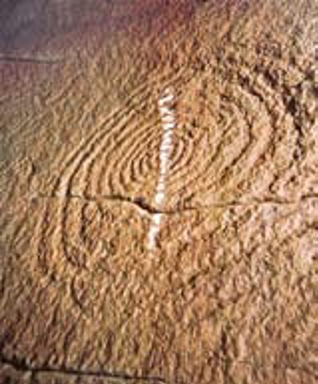
The Sun Dagger Monument, Chaco Canyon Stone with Sun on the Summer Solstice
The Sun Dagger
Some 50 miles or so to the west of here lies Chaco Canyon. There, atop a narrow, high, and relatively inaccessible butte is a side by side arrangement of stone slabs that channel rays of the sun onto a perpendicular stone on which is inscribed a spiral. It is known as “The Sun Dagger Monument” and dates to the Anasazi, or Early Pueblo, people. These are the ancestors of the present day tribal societies of the nineteen Pueblos in New Mexico as well as the Hopi in Arizona. On the solstices, the sun aligns with the spaces between the stones, creating a dagger of light which points to the center of the spiral, thereby marking the ending and beginnings of the solar year. Although specifics of its use are not known, it is safe to conclude that it was likely both a sacred and a practical expression of an agricultural society whose reliance on knowing when to plant was critical. Of course we can’t tell to what extent it was regarded as sacred and to what extent practical, but it seems likely that it was fully both, too fully intermingled to be separated, and its virtually inaccessible location suggests the depth of its sacred meaning.
Modern scientific instruments that accurately tell us of the solstices are not regarded by us as sacred. They are far more convenient of course—one doesn’t have to make a dangerous climb up a tall butte to check them out—but on the other hand we don’t really sense from those digital instruments that the sun has reached the highest position in the sky before the decent into winter, or that we’ve come to the longest day of the year before the days begin again to shorten bit by bit into winter’s night—even though we know that is what’s happening when we stop to think about it.

Pueblo Bonito Ruins, Chaco Canyon, New Mexico
Chaco Canyon
There are ruins of settlements in the same canyon some distance away that must have been built by the people who created the sun dagger. The form of those settlements suggest that they too were shaped by a sacred order. The largest ruin is called Pueblo Bonito and is in fairly good condition for having been abandoned more than 800 years ago. It appears that its inhabitants eventually moved into the Rio Grande Valley, likely to be nearer water in times of drought, thereby creating today’s pueblos.
It is reasonable to expect that rituals took place at Pueblo Bonito and other settlements of Chaco Canyon on the solstices—something that doesn’t happen in a modern Western setting that I know of, except in Scandinavia. If we were in Sweden on the upcoming summer solstice weekend we’d be wishing one another Trevlig Midsommars Afton—or, Happy Mid-Summer’s Eve. And there would be various celebrations taking place in public parks and in people’s homes. This is the Scandinavian holiday featured in Shakespeare’s “Midsummer’s Night’s Dream,” and although usually a bit more subdued today compared to the Shakespearian version, it is still celebrated. There are very few holidays left among industrialized countries that celebrate particular events in Nature. It seems we have moved to far from nature to feel the need to engage it so directly. Another exception by the way is Japan, where a combination of the indigenous Shinto religion and the popularity of the Zen sect of Buddhism encourage a frequent recognition of Nature as the ultimate object of spirituality. But for the rest of us, celebrations of natural events have been eliminated, often replaced with new holidays that have a different focus. For us Nature is most commonly understood through the abstractions of modern science.
Traditional Understanding of Nature
A characteristic of traditional societies, by contrast, has is to regard the world of their own making as analogous to nature—as a sort of man-made nature. Tribes of the Pacific Northwest, for instance, built lodges, or “plank houses,” where the hearth with smoke-hole above it during certain rituals at special times of year represented the axis mundi, and the light that enters the smoke hole represented enlightenment from the spiritual world above. The four corner posts represented the four quarters of creation, and the floor was of the earth upon which we live, while placement of the lodge itself—located between the beach and the woods behind it—represented a sort of neutral place between the sea and the forest, those two parts of the earth where food and firewood is gathered to maintain their lives.
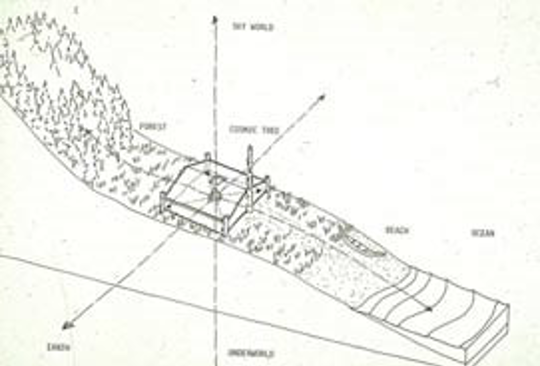
Haida Plank House, Pacific Northwest
Two Views of Nature
One could argue that there are just two ways to understand our relationship with nature and they seem to be mutually contradictory. We are endowed by evolution with a sense of spirituality—it is intrinsic to the human condition because it is hard-wired in our brains, and then it is up to us (and our cultures) to deal with how it manifests itself in our lives. From the perspective of evolutionary science we may assume it came into being to help ensure our survival. However, knowing that, we are confronted with a dilemma. While science explains evolution, does it then completely take the place of those ancient more intuitive, existential sensibilities? Modern thought, at least in the purest sense, would suggest that it indeed does. In fact, seen narrowly and only through the lens of science, regarding nature as sacred is a kind of superstition. On the other hand, doesn’t science so often fail to provide the necessary deep motivation that only comes from a more concrete sense of the natural world? Science all to often tends to dull our ability to care, suspending moral responsibility toward nature.
All this is to say that in the best of all worlds each way of thinking informs the other, no matter how different they appear to be. It might be said that one way alone makes for a stunted view. Some 50 years ago the poet Archibald McLeish said it this way:
“The old relationship between man and world—a relationship once heavy with myth and intimate with meaning—has been replaced by our new, precise, objective, dispassionate observation of the world. With the result that our understanding of our experience of the world has been curiously mutilated. The world is still there—more there than ever— bright and sharp and analyzed and explicable. But we ourselves, facing the world, are not there. Our knowledge that is to say seems to exist . . . independently of us, or indeed any knower—scientific knowledge stated in its universal scientific laws, its formulas and equations true for all men everywhere and always, not for a single man alone.”
I’ll refer to these two ways of understanding nature as scientific and humanistic. Two thoughtful scientists who have written extensively on just that are biologist Edward O. Wilson, and anthropologist and historian of science Loren Eisley. Both argue that only in the coming together of the two ways of thinking may we find the fullest understanding of nature, as well as of ourselves—that is, our own nature. Wilson referred to that coming together as “a consilience towards a unity of knowledge” and Eisley, speaking of more narrow minded scientists, put it this way:
“It is the reductionist who, too frequently, would claim that the end justifies the means, who would assert reason as his defense and let that mysterium which guards man’s moral nature fall away in indifference, a phantom without reality.1
Wilson agrees:
“Only fluency across the boundaries [between science and humanism] will provide a clear view of the world as it really is . . . “2 “Magic enters the mind seductively, like a drug in the veins. [By] accepting its emotive power, we know something important about human nature. And something important intellectually—that [only] in expanded space-time the fiery circle of science and the arts can be closed.”3
We hear a lot today about how we’ve distanced ourselves from nature, and that if we can’t reverse what we’ve been doing it will be to our peril. We cross continents and oceans in the comfort of airplanes and automobiles, our buildings isolate us from the discomforts of weather’s heat and cold, and electric lights shut out the darkness of night. Our ancient ancestors, on the other hand, intuitively saw themselves to be integral to what we call nature. Their sense of it was necessarily concrete, and their understanding both practical and sacred. Nature itself was filled with magic, enchantment and spirituality, and if one failed to recognize its meaning, the consequences could be dire. Of course sometimes they were. The book Collapse by Jered Diamond chronicles such circumstances in the ancient world, both failures and successes.4 So the question for us becomes: Can we re-establish a balance with the natural world without a transcendent sense of nature—that is, with only a scientific frame of mind, aloof, abstract, and apart? Certainly McLeish, Wilson and Eisley tell us that we indeed cannot.

Village of Ácoma atop Sky City Mesa (HABS drawing)

Ácoma Pueblo, Sky City Mesa, New Mexico
The Ácoma Deer Feast
Let me digress for a moment. Here’s an example of the kind of concrete connection to nature that characterizes a traditional sense of the natural world. I’ve recently become acquainted with an Ácoma family and have been privileged to be invited by Mary, a most generous and astute woman of the tribe, to feast days at her house in Sky City atop the Ácoma’s Mesa. On such feast days family and friends stop by throughout the afternoon to sit for a time at Mary’s table after helping themselves to things bubbling on her two iron wood-stoves—then they chat with one another for a while after which they stroll down to the plaza to watch the dances dedicated to that particular feast day. On most occasions the feast day takes place across the pueblo, with similar events going on in many houses—but on one particular occasion, usually in late autumn, the feast celebrates one of the men of the clan having shot a deer, and the feast features venison from the recently slain animal.


Mary’s son Aaron (left) and the altar (right) for the Deer Dinner, located beside the dining table.
Before the meal, prayers—in Keres, their tribal language—are recited for the soul of the deer. A kind of altar has been set up in the corner of the room, with the skull of the slain dear as its centerpiece. Several of the women at the table sob as they pray in their grief for the deer they are about to dine upon. On a recent occasion, a very elderly woman of Mary’s clan explained after the meal that in the “old days” most families at Ácoma held such deer feasts—but nowadays, she said, fewer and fewer families carry on the tradition. She went on to explain that the ritual events that accompany the deer feast are important to the Ácomas because they are symbolic of the tribe’s connection to the life-sustaining land on which they raised their food (traditionally beans, corn, and squash and where they harvested the animals, and plants that provide them with wild seeds, berries, fruits) and on which stands the mountain of sacred places (Kaweshtima; on the maps referred to as Mt. Taylor), which gives them the river that supplies their water and the deer and other animals that provide them with much needed food for the winter. She became teary-eyed—now an old woman who sees times of greater sensitivity towards nature slowly fading—as she explained how important it is to carry on these traditions so that the bond between the people and their land remains unbroken.

Street Scenes, Ácoma Pueblo
Well—imagine for the moment one of us praying for the steer who had been sacrificed to supply us with a nice steamship round of roast beef. For most of us our culture doesn’t urge us to do any such thing. But the Ácoma deer feast, I think, demonstrates how a particular traditional culture consciously sought to maintain a connection with nature. And by ‘consciously’ I refer back to the woman who lamented that many families of Ácoma no longer hold deer feasts that include the traditional ritual as still takes place in Mary’s clan.
The Umbilical Connection
Here is one more example. A friend and former student of mine who is Navajo strives to maintain certain traditions of his heritage even though globalization wants to render them anachronistic. One tradition is language. He speaks the Navajo language—or Diné—at home so that his two young sons will learn it naturally. The other practice he described to me was to take the umbilical cord at the birth of each of their sons, place it in an appropriate vessel, then bury it in a special place—clearly marked, so that their sons when they are older can return to their own personal “earth centers,” to be reminded that each has a center, a sort of personal earth-navel of his own. Their father explained to me that this was a custom of his people who, unlike the pueblos people, were a nomadic society, without a center on earth, so that a personal earth-navel provides a psychological center for them somewhere within the vast natural landscape they call home.
Sense of Place
Efforts by traditional societies around the world to perpetuate certain cultural practices that seek to keep them in harmony with nature are of course an ongoing struggle in this age of globalization. Their struggles remind us that we all would benefit from maintaining an intuitive, ongoing, concrete sense of the natural world. In New Mexico, at least some here and there have been able to maintain important parts of a pre-European culture in spite of the crisis of the Spanish Invasion and more recent modernization, including the commercialization of just about everything you can think of. The 19 pueblos that lie within in the Rio Grande Valley, and the villages on the three Hopi mesas in Arizona, have been occupied continuously for eight hundred years and to more than a thousand for some. I think it safe to assume that continuity of place has been enormously important to the preservation of their cultures. Of course their cultures are far from intact compared to before the Spanish conquest that began in 1540, but as settled societies the places where they reside on earth certainly must have helped to preserve some of their traditions in the face of enormous change. Compared to formerly nomadic societies around them, I suspect that the pueblo people are the lucky ones.
Knowing and valuing permanent things—things that extend beyond fragile human mortality— must be intrinsic to the human condition. Rina Swentzell of Santa Clara Pueblo has described how houses within her pueblo are regarded as though they were living things—having a life which eventually decays and returns to the earth. Houses are mortal and must be allowed to grow old, decay, and eventually die, to be replaced by the new as part of a natural pattern of death and renewal. Yet at the same time their place on earth, the pueblo itself, remains. Its presence, like nature is, for all practical purposes, a permanent one. Philosopher and phenomenologist Hannah Arendt, speaking of European villages, described it this way:
“Nowhere else does the sheer durability of the world of things appear in such purity and clarity, nowhere else therefore does this thing-world reveal itself so spectacularly as in the non-mortal home for mortal beings. It is as though . . . something immortal [is] achieved by mortal hands, [and] has become tangibly present . . .”5
A local example of what Arendt speaks about may be found at the pueblo of Taos. Taos secures its place in nature in part by reflecting the eternal mountains that lie beyond it. The form of the pueblo mimics in its manmade rectilinear profile the mountains themselves, while the passages between the houses flow to the plaza like streams tumbling out of the mountains to lakes at their base. During festivals, dancers make their way along these passages and finally come together in the plaza—while people watch from the parapets of their houses—positioned as though on cliffs and mountain sides—all becoming a part of the festival as they watch the flow of dancers and listen to the drums and chants.

Lower houses across from the plaza, with lower mountains beyond, Taos Pueblo

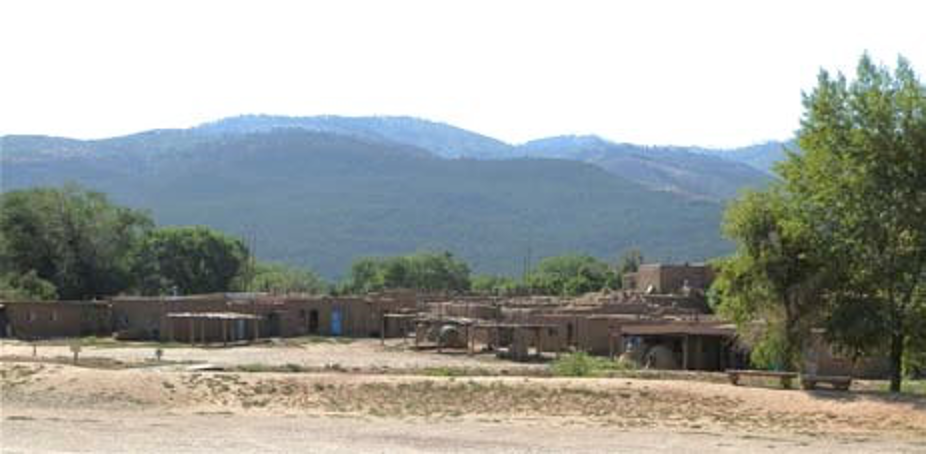
Aerial View and Plan Drawing, Taos Pueblo.
Learning from Traditional Cultures
Is there something we can learn from the wisdom of these traditional societies, something that, as Wilson said, may “close the fiery circle of science and the arts”? Perhaps there are direct links to the understanding of nature in Western Civilization—ones that reflect what we see in traditional societies. Before I end, I would like to remind you that there are such links, ones intrinsic to western mythology. And I’m convinced they can still inspire us.
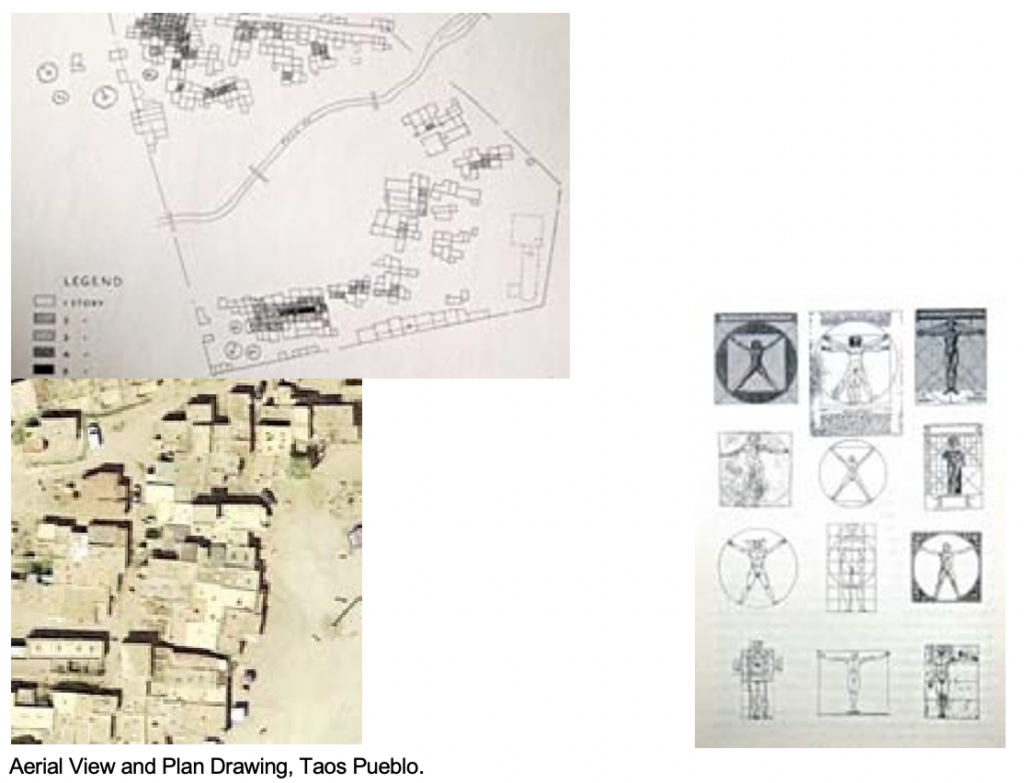
Evolution of the primitive hut from its beginning to a sophisticated stone temple, and Renaissance Drawings of human proportions and corresponding geometry, based on Vitruvius’ description in The Ten Books on Architecture.
For instance there is Vitruvius’ description of the myth of the primitive hut, where he tells us that it demonstrates how architecture can follow “the ways of Nature.” In his description “The men of old, gifted beyond the other animals” could “do with ease whatever they chose with their hands and fingers.” So “they began in that first assembly to construct shelters.” He goes on to describe architecture as having come about by trial and error—what we might call evolution—and he speaks of how each would-be inventor emulated the discoveries and inventions of his colleagues, until their combined efforts, as he puts it, “reached the perfection of Nature.” The Doric Order of course is the most succinct paradigm, and even though having eventually gone through a transition in the history of building from wood to stone, it forever retains the marks of its origin in nature. Renaissance architects recognized this and each sixteenth and seventeenth century architect worth his salt drew his own version of the mythical primitive hut and remarked upon how it, as Vitruvius described, “followed the truth of Nature.”
Other parts of the myth, as you’ll recall, described how pleasing proportions in the things we build relate to the proportions of the human body, itself a part of nature. And again, Renaissance architects drew the human body as related to abstract geometries as a means to ensure that buildings remain in harmony with our perception of the form nature has given us.
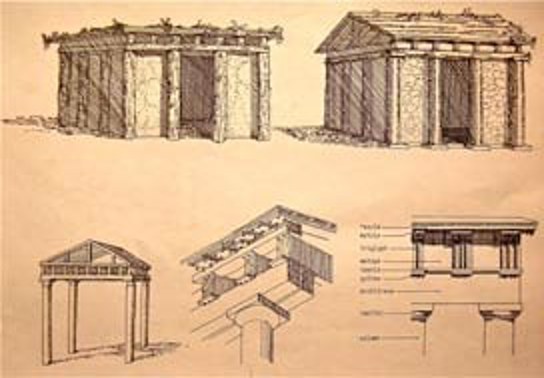
Still another of the ancient myths of western architecture told by Vitruvius involves the invention of the Corinthian order. He tells us that “a freeborn maiden of Corinth, just of marriageable age, was attacked by illness and died. After her burial, her nurse, collecting a few little things which used to give the girl pleasure . . . put them in a basket . . . and [covered it] with a roof-tile so that the things might last longer in the open air. The basket happened to be placed just above the root of an acanthus. . . . [When] springtime came it put forth leaves . . . growing up along the sides of the basket. . . . Just then Callimachus . . . [a sculptor of Corinth] passed by . . . and observed the basket with the tender young leaves growing round it.”
Beauty
The basket with its precious things and the acanthus struggling to survive presented to him a harmonious ensemble of manmade things and nature. This inspired him to invent what we know as the Corinthian capitol. Now, each time we see a capitol of the Corinthian order we are reminded of the tragedy of the young woman, but at the same time we are reminded that life goes on, and, like the plant’s struggle against great odds, adversity may sometimes produce things of great beauty. We see in it, beauty, and that gives us hope.
The Navajo have a sort of mantra that seeks after beauty in all that is around us. I’m told It is to be remembered as one is walking in the desert.
“I walk with beauty before me; I walk with beauty beside me; I walk with beauty behind me; I walk in beauty.”
References
- Loren Eiseley, The Star Thrower, from the essay “Science and the Sense of the Holy,” (New York: Random House, 1978), p. 190.
- Edward O. Wilson, Consilience: The Unity of Knowledge, (New York: Random House, 1998), p.
13. 3 Ibid., p, 237. 4 Jared Diamond, Collapse: How Societies Choose to Fail or Succeed, (New York: Penguin Group, 2006).
5 Hannah Arendt, The Human Condition (Chicago: Univ. of Chicago Press, 1958) p 167-168.




